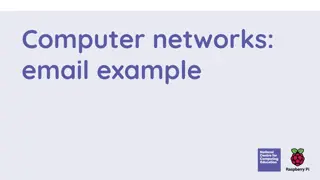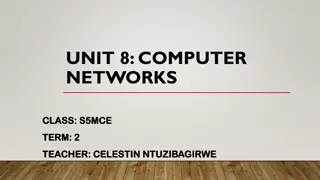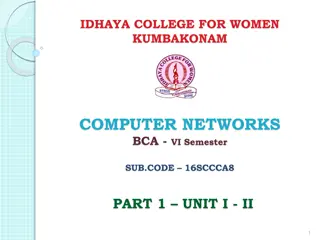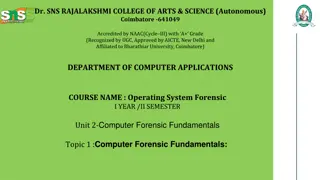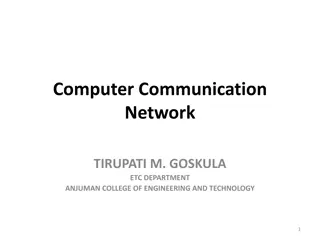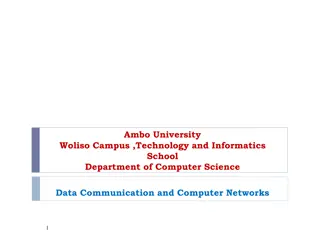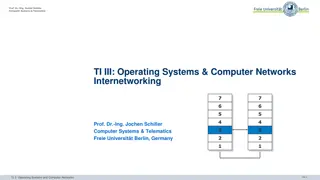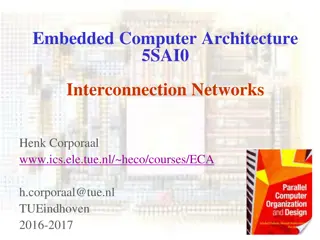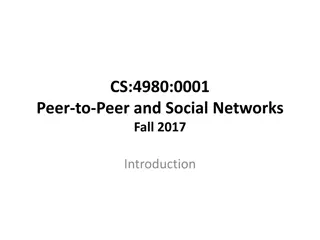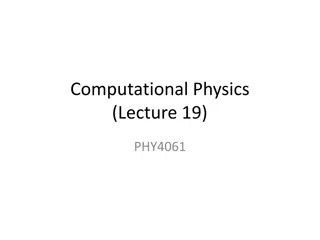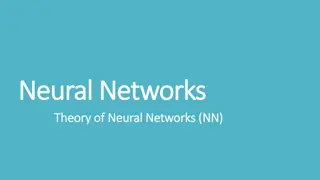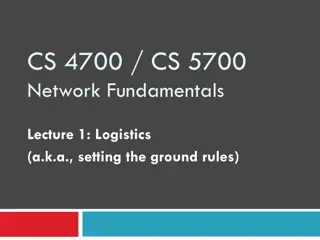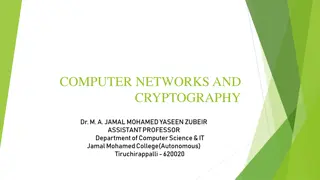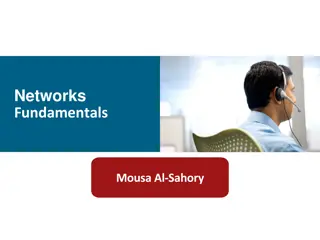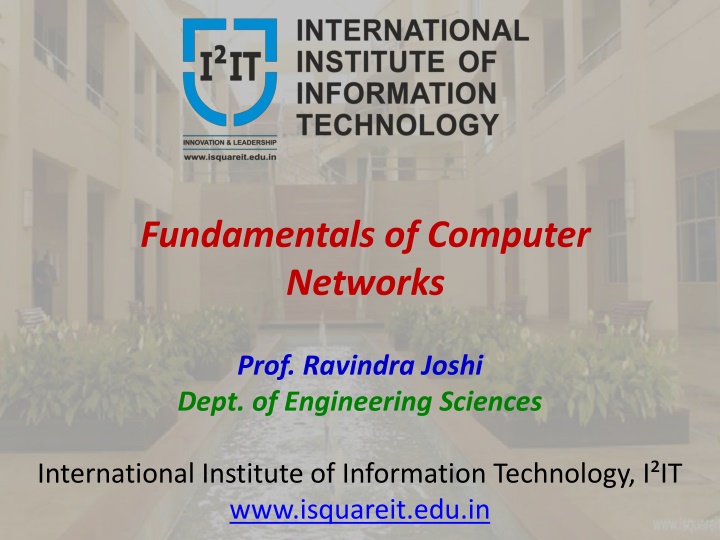
Computer Networks and OSI Model at International Institute of Information Technology
Explore the fundamentals of computer networks, including the concept of layering and the OSI model for computer communication at International Institute of Information Technology. Learn about interconnected devices, network layer architecture, and the Open System Interconnection model for seamless communication between systems.
Download Presentation

Please find below an Image/Link to download the presentation.
The content on the website is provided AS IS for your information and personal use only. It may not be sold, licensed, or shared on other websites without obtaining consent from the author. If you encounter any issues during the download, it is possible that the publisher has removed the file from their server.
You are allowed to download the files provided on this website for personal or commercial use, subject to the condition that they are used lawfully. All files are the property of their respective owners.
The content on the website is provided AS IS for your information and personal use only. It may not be sold, licensed, or shared on other websites without obtaining consent from the author.
E N D
Presentation Transcript
Fundamentals of Computer Networks Prof. Ravindra Joshi Dept. of Engineering Sciences International Institute of Information Technology, I IT www.isquareit.edu.in
Fundamentals of Computer Networks What is a Computer Network ?? What is a Computer Network ?? It is a interconnected collection of autonomous devices (or nodes) for the purpose of resource sharing. Interconnected: connected by communication links (or transmission medium) Autonomous: each device is independent of the other does not have master/slave relation Node: Any addressable device that can recognize, process or forward data transmissions. E.g. computer, server, workstation, printer etc. International Institute of Information Technology, I IT, P-14, Rajiv Gandhi Infotech Park, Hinjawadi Phase 1, Pune - 411 057 Phone - +91 20 22933441/2/3 | Website - www.isquareit.edu.in | Email - info@isquareit.edu.in 2
Concept of Layering Concept of Layering In order to simplify understanding and reduce design complexity, a network is conceptually visualized as a stack of various layers. Various network models are available using this type of layered architecture such as, Internet model OSI reference model TCP/IP model etc. Number of layers, names of layers, functions of layers may differ for different network models Modularity: Functions of each layer are distinct and layers are independent of the others, allows for scalability (or future expansion) International Institute of Information Technology, I IT, P-14, Rajiv Gandhi Infotech Park, Hinjawadi Phase 1, Pune - 411 057 Phone - +91 20 22933441/2/3 | Website - www.isquareit.edu.in | Email - info@isquareit.edu.in 3
OSI model for computer communication OSI model for computer communication Open System Interconnection (OSI) model was invented by International Standards Organization (ISO) Open system is a model that, allows two different systems to communicate regardless of their fundamental architecture establishes communication between different systems without requiring changes in the logic of basic hardware or software OSI is a reference model (not a protocol) Each layer uses and builds on the services provided by those below it OSI reference model consists of 7-layers Functions and services provided by each layer are clearly defined International Institute of Information Technology, I IT, P-14, Rajiv Gandhi Infotech Park, Hinjawadi Phase 1, Pune - 411 057 Phone - +91 20 22933441/2/3 | Website - www.isquareit.edu.in | Email - info@isquareit.edu.in 4
OSI model for computer communication OSI model for computer communication International Institute of Information Technology, I IT, P-14, Rajiv Gandhi Infotech Park, Hinjawadi Phase 1, Pune - 411 057 Phone - +91 20 22933441/2/3 | Website - www.isquareit.edu.in | Email - info@isquareit.edu.in 5
TCP/IP model for computer communication TCP/IP model for computer communication TCP/IP is a dominant commercial protocol architecture Since 1990 it became popular Is a result of research conducted On packet switched networks, Advanced Research Project Agency Network (ARPANET) It was funded by Defense Advanced Research Project Agency (DARPA) of US Department of Defense (DOD) It was used for Inter connection of different networks developed by different vendors It contains only 4-layers (simplified version of OSI model) International Institute of Information Technology, I IT, P-14, Rajiv Gandhi Infotech Park, Hinjawadi Phase 1, Pune - 411 057 Phone - +91 20 22933441/2/3 | Website - www.isquareit.edu.in | Email - info@isquareit.edu.in 6
TCP/IP Layers TCP/IP Layers Application Layer Transport Layer Internet Layer Host-to-network Layer International Institute of Information Technology, I IT, P-14, Rajiv Gandhi Infotech Park, Hinjawadi Phase 1, Pune - 411 057 Phone - +91 20 22933441/2/3 | Website - www.isquareit.edu.in | Email - info@isquareit.edu.in 21-06-2017 7
TCP/IP Layers and services TCP/IP Layers and services Application Layer: - Mail services, file transfer, remote log-in, accessing world wide web etc. Transport layer: Transmission Control Protocol (TCP) User (or Universal) Datagram Protocol (UDP) Ensures reliable delivery, retransmission in case of error Internet Layer: Internet Protocol (IP) Host-to-network Layer: Data Link plus physical layer combined Uses any media access Protocol (e.g. Ethernet for LAN) International Institute of Information Technology, I IT, P-14, Rajiv Gandhi Infotech Park, Hinjawadi Phase 1, Pune - 411 057 Phone - +91 20 22933441/2/3 | Website - www.isquareit.edu.in | Email - info@isquareit.edu.in 21-06-2017 8
Communication between layers Communication between layers International Institute of Information Technology, I IT, P-14, Rajiv Gandhi Infotech Park, Hinjawadi Phase 1, Pune - 411 057 Phone - +91 20 22933441/2/3 | Website - www.isquareit.edu.in | Email - info@isquareit.edu.in 9
Communication between layers Communication between layers Each layer receives data and appends control information (header & trailer) to it and passes on to the layer below Actual transmission of data takes place through physical layer in the form of bits (0 s and 1 s). Transmission medium is required for the data flow. Layers may break the message in smaller packets Each packet is numbered and contains control information such as destination and source address Upon reaching the correct destination, the data packets are forwarded to the upper layers and the corresponding header & trailer are removed at each layer International Institute of Information Technology, I IT, P-14, Rajiv Gandhi Infotech Park, Hinjawadi Phase 1, Pune - 411 057 Phone - +91 20 22933441/2/3 | Website - www.isquareit.edu.in | Email - info@isquareit.edu.in 10
Functions of Layers: physical layer Functions of Layers: physical layer Description & functions- Responsible for transmission of bits from one node to another over a communication channel. Deals with mechanical, electrical, functional and procedural specifications. - Mechanical (e.g. type of connectors) - Electrical (e.g. voltage levels, data transmission rates) - Functional (e.g. specifies functions performed by individual pins) - Procedural (e.g. specifies sequence of events by which bit streams are exchanged) International Institute of Information Technology, I IT, P-14, Rajiv Gandhi Infotech Park, Hinjawadi Phase 1, Pune - 411 057 Phone - +91 20 22933441/2/3 | Website - www.isquareit.edu.in | Email - info@isquareit.edu.in 11
Functions of Layers: physical layer Functions of Layers: physical layer Defines interface between devices and transmission media (e.g. RS232C, RS-485) as well as type of transmission media. Representation of bits (e.g. electrical or optical signals) Protocols used: X.21 Services provided to the data link layer: Defines physical media characteristics, data rates, synchronization of bits, representation of bits, sequence of transmission etc. International Institute of Information Technology, I IT, P-14, Rajiv Gandhi Infotech Park, Hinjawadi Phase 1, Pune - 411 057 Phone - +91 20 22933441/2/3 | Website - www.isquareit.edu.in | Email - info@isquareit.edu.in 12
Functions of Layers: data link layer Functions of Layers: data link layer Description & functions- Transforms the physical layer, a raw transmission facility to a reliable link. Provides error detection & correction mechanisms Converts stream of bits into frames Attaches specific bit patterns (such as header, trailer) to the beginning and end of frames. Deals with damaged, lost and duplicate frames Provides flow control if sender and receiver speeds are not matching. Controls access to the shared media. International Institute of Information Technology, I IT, P-14, Rajiv Gandhi Infotech Park, Hinjawadi Phase 1, Pune - 411 057 Phone - +91 20 22933441/2/3 | Website - www.isquareit.edu.in | Email - info@isquareit.edu.in 13
Functions of Layers: Network layer Functions of Layers: Network layer Description & functions- Responsible for delivery of packets from source to destination across multiple networks. Provides logical addressing (e.g. IP address) to identify sender and receiver. Provides routing of packets through best possible path Congestion control in case of busy or broken routes Protocols used: X.25 International Institute of Information Technology, I IT, P-14, Rajiv Gandhi Infotech Park, Hinjawadi Phase 1, Pune - 411 057 Phone - +91 20 22933441/2/3 | Website - www.isquareit.edu.in | Email - info@isquareit.edu.in 14
Functions of Layers: Transport layer Functions of Layers: Transport layer Description & functions- Responsible for delivery of entire message from source to destination (process-to-process delivery) Provides establishment, data transfer and notification of connection release Port addressing: network layer gets the packets to the correct computer and transport layer gets the entire message to the correct process on that computer Segmentation & reassembly of message Connection control: offers connection-oriented or connection-less service International Institute of Information Technology, I IT, P-14, Rajiv Gandhi Infotech Park, Hinjawadi Phase 1, Pune - 411 057 Phone - +91 20 22933441/2/3 | Website - www.isquareit.edu.in | Email - info@isquareit.edu.in 15
Functions of Layers: Session layer Functions of Layers: Session layer Dialogue discipline: Control of dialogues between applications Establishes, maintains and synchronises the interaction Session closes with proper procedure, not abruptly Exception handling: Covers exceptional situations not covered by other layers Session Recovery: Provides checkpoint mechanism If failure between check points-session retransmit data from the last check point Session Release: In case of idle time International Institute of Information Technology, I IT, P-14, Rajiv Gandhi Infotech Park, Hinjawadi Phase 1, Pune - 411 057 Phone - +91 20 22933441/2/3 | Website - www.isquareit.edu.in | Email - info@isquareit.edu.in 16
Functions of Layers: Presentation layer Functions of Layers: Presentation layer Responsible for presentation of data in a meaningful way to the application layer. Defines syntax and semantics used between application entities Data formats, Data translation, Coding/ decoding Data compression/ decompression Encryption/ decryption for secured data transmission Security: Validating Login/password International Institute of Information Technology, I IT, P-14, Rajiv Gandhi Infotech Park, Hinjawadi Phase 1, Pune - 411 057 Phone - +91 20 22933441/2/3 | Website - www.isquareit.edu.in | Email - info@isquareit.edu.in 17
Functions of Layers: Application layer Functions of Layers: Application layer Enables the user to access the network using an application software Provides user interfaces and services such as, Electronic mail services File transfer and access services Remote log-in to access network resources Access to the World Wide Web International Institute of Information Technology, I IT, P-14, Rajiv Gandhi Infotech Park, Hinjawadi Phase 1, Pune - 411 057 Phone - +91 20 22933441/2/3 | Website - www.isquareit.edu.in | Email - info@isquareit.edu.in 18
Network topologies International Institute of Information Technology, I IT, P-14, Rajiv Gandhi Infotech Park, Hinjawadi Phase 1, Pune - 411 057 Phone - +91 20 22933441/2/3 | Website - www.isquareit.edu.in | Email - info@isquareit.edu.in 19
Network topologies Mesh topology International Institute of Information Technology, I IT, P-14, Rajiv Gandhi Infotech Park, Hinjawadi Phase 1, Pune - 411 057 Phone - +91 20 22933441/2/3 | Website - www.isquareit.edu.in | Email - info@isquareit.edu.in 20
Network topologies Characteristics Each device is connected to every other device by point-to-point (or dedicated) links Number of links = n(n-1)/2 Advantages Robust: If one link fails, alternate route is available Dedicated links, more security, more reliability Data can be routed to avoid busy links No congestion and link allocation problems High data rates are possible (few Gbps) Disadvantages High cabling cost, more I/O ports required Extremely complex if the number of nodes are more Installation and adding users is difficult 21
Network topologies Star topology International Institute of Information Technology, I IT, P-14, Rajiv Gandhi Infotech Park, Hinjawadi Phase 1, Pune - 411 057 Phone - +91 20 22933441/2/3 | Website - www.isquareit.edu.in | Email - info@isquareit.edu.in 22
Network topologies Characteristics: Each device is connected by point-to-point links to the central controller (and not directly) All data traffic is routed through the central controller Advantages Centralized control, Easy to locate faults Easy to add or delete nodes Robust: if one link fails, network will not get affected Easy to install & configure, less I/O ports required Less cabling required compared to mesh topology (hence less expensive than mesh topology) Disadvantages If central controller fails, entire network gets affected 23
Network topologies Bus topology International Institute of Information Technology, I IT, P-14, Rajiv Gandhi Infotech Park, Hinjawadi Phase 1, Pune - 411 057 Phone - +91 20 22933441/2/3 | Website - www.isquareit.edu.in | Email - info@isquareit.edu.in 24
Network topologies Characteristics: Each device is connected to a central cable called as backbone (or data highway) Multi-point connection Advantages Easy to add or delete nodes Easy to install & configure Less cabling required compared to mesh or star topology (hence less expensive) Disadvantages Access mechanism is required (to decide which device gets access to the medium) Limitations on distance due to interference Entire network is affected if backbone cable is broken 25
Network topologies Ring topology International Institute of Information Technology, I IT, P-14, Rajiv Gandhi Infotech Park, Hinjawadi Phase 1, Pune - 411 057 Phone - +91 20 22933441/2/3 | Website - www.isquareit.edu.in | Email - info@isquareit.edu.in 26
Network topologies Characteristics: Each device has dedicated point-to-point connection only with two devices, on either side of it Signal is passed from one device to another until it reaches the destination and is regenerated at each node Advantages Easy to add or delete nodes Easy to install & configure Less cabling required compared to mesh or star topology (hence less expensive) Disadvantages Access mechanism is required (to decide which device gets access to the medium) Entire network is affected if ring cable is broken 27
Categories of Networks International Institute of Information Technology, I IT, P-14, Rajiv Gandhi Infotech Park, Hinjawadi Phase 1, Pune - 411 057 Phone - +91 20 22933441/2/3 | Website - www.isquareit.edu.in | Email - info@isquareit.edu.in 28
Categories of Networks Characteristics of Local Area Network (LAN): Covers limited geographic area: office, building or a campus (10 m to 1 Km) Usually owned by private companies or institutions Data rates are high (10 to 100 Mbps or higher) Data transmission through twisted pair cable, or Fiber optic cable Less delay, very few errors, no switching elements required Main purpose to share resources in an organization Protocols used: Ethernet, Token ring, Token bus International Institute of Information Technology, I IT, P-14, Rajiv Gandhi Infotech Park, Hinjawadi Phase 1, Pune - 411 057 Phone - +91 20 22933441/2/3 | Website - www.isquareit.edu.in | Email - info@isquareit.edu.in 29
Categories of Networks Metropolitan Area Network (MAN): International Institute of Information Technology, I IT, P-14, Rajiv Gandhi Infotech Park, Hinjawadi Phase 1, Pune - 411 057 Phone - +91 20 22933441/2/3 | Website - www.isquareit.edu.in | Email - info@isquareit.edu.in 30
Categories of Networks Characteristics of Metropolitan Area Network (MAN): Covers geographic area of a typical metropolitan city (5 to 50 Km) Owned by private or public companies (such as banks) or telephone companies Data rates are high (10 to 100 Mbps) Data transmission through coaxial cable or Fiber optic cable Main purpose to connect various LANs in a city Technologies used: SMDS, FDDI, ATM Links between LANs could also be wireless (e.g. microwave or radio) International Institute of Information Technology, I IT, P-14, Rajiv Gandhi Infotech Park, Hinjawadi Phase 1, Pune - 411 057 Phone - +91 20 22933441/2/3 | Website - www.isquareit.edu.in | Email - info@isquareit.edu.in 31
Categories of Networks Wide Area Network (WAN): International Institute of Information Technology, I IT, P-14, Rajiv Gandhi Infotech Park, Hinjawadi Phase 1, Pune - 411 057 Phone - +91 20 22933441/2/3 | Website - www.isquareit.edu.in | Email - info@isquareit.edu.in 32
Categories of Networks Characteristics of Wide Area Network (WAN): Covers very large geographic area: country or even different continents (100 to 1000 Km or more) Utilize public, leased communication lines from telephone companies or carrier providers (e.g. AT&T, USsprint, MCI, SingTel etc.) Transmission rates up to 625Mbps but will be limited by the end infrastructure Data transmission through Fiber optic cable or Satellite wireless links Main purpose is to connect networks across different countries Technologies used: ATM, SONET Internetworking devices such as routers are used 33
Internet Internet is a network of networks (or interconnection of various networks) It was an outcome of research work done at Advanced Research Project Agency (ARPA) in early 1970 s. Protocol used: TCP/IP It s a collection of transmission control protocol and Internet protocol International Service Providers National Service Providers Regional internet service providers Local internet service providers International Institute of Information Technology, I IT, P-14, Rajiv Gandhi Infotech Park, Hinjawadi Phase 1, Pune - 411 057 Phone - +91 20 22933441/2/3 | Website - www.isquareit.edu.in | Email - info@isquareit.edu.in 34
Internet International Institute of Information Technology, I IT, P-14, Rajiv Gandhi Infotech Park, Hinjawadi Phase 1, Pune - 411 057 Phone - +91 20 22933441/2/3 | Website - www.isquareit.edu.in | Email - info@isquareit.edu.in 35
For further queries, Kindly contact: Prof. Ravindra Joshi Associate Professor, Dept. of Engineering Sciences International Institute of Information Technology (I2IT), Pune Email: ravindraj@isquareit.edu.in Cell: 9822021594 International Institute of Information Technology, I IT, P-14, Rajiv Gandhi Infotech Park, Hinjawadi Phase 1, Pune - 411 057 Phone - +91 20 22933441/2/3 | Website - www.isquareit.edu.in | Email - info@isquareit.edu.in

